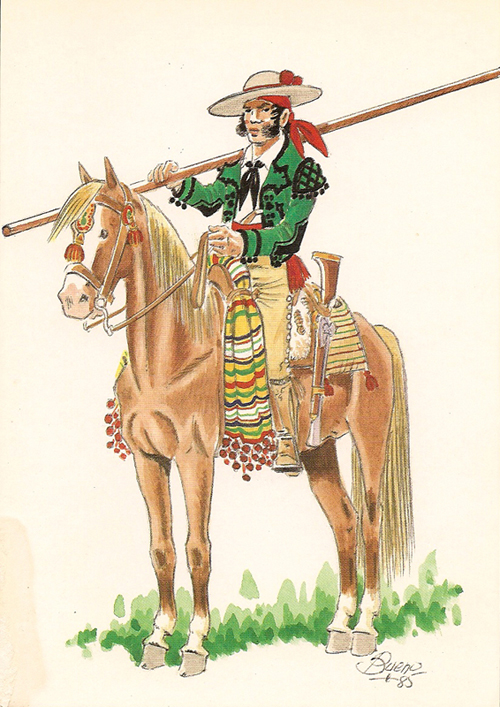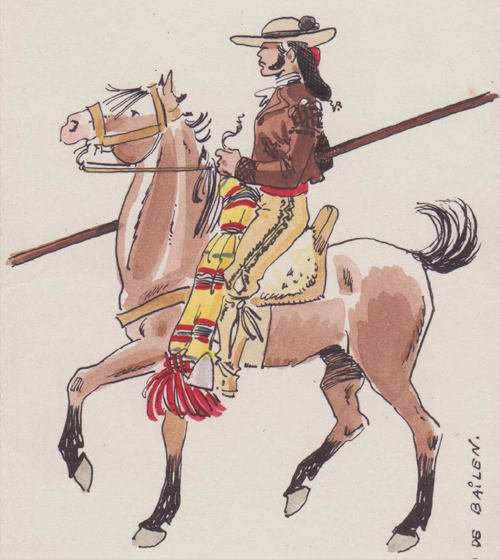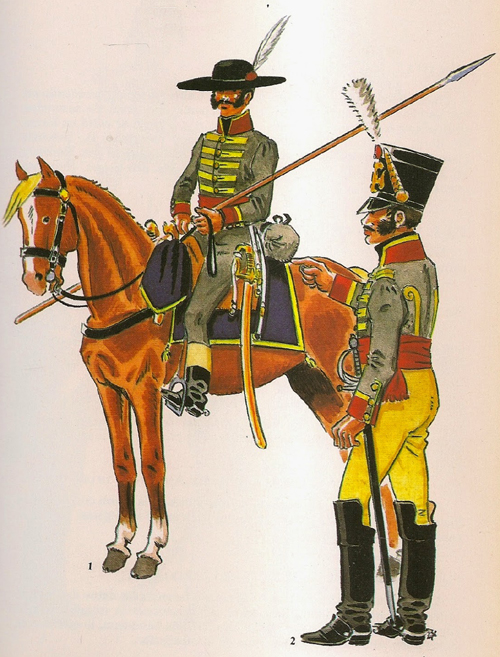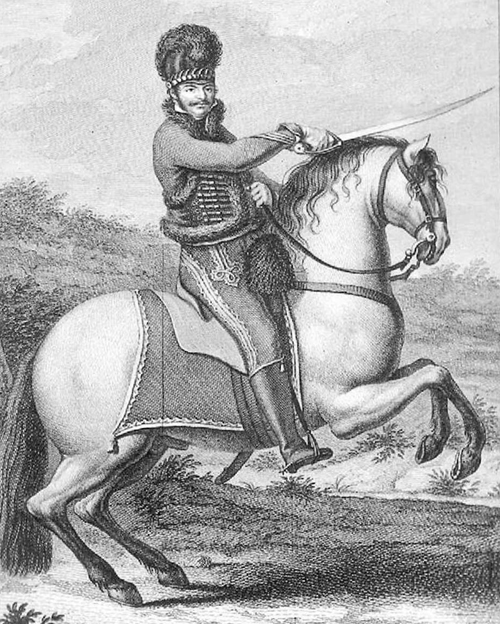|
Spanish Lancers - Lanceros y GarrochistasGarrochistasThe Spanish formed a number of volunteer lancer units from Andalusian cattlemen (Garrochistas) who used a lance like weapon to prod their bulls. They were not uniformed, but wore their regional costume. They are depicted in green or brown jackets, buff breeches, red head scarves, and broad charro hats. Two troops of lancers (Lanceros de Utrera and Lanceros de Jerez) totaling 104 men fought on the Spanish left at Bailen.
Lancers of Don Julián Sánchez "El Charro"One of the most famous lancer units raised during the Peninsular War was that of Don Julián Sánchez. Don Julián was called El Charro because he was from the province of Salamanca (born in Muñoz) and it was from there his lancers were raised. At the outbreak of the Peninsular War, Julián Sánchez went to Ciudad Rodrigo and enlisted in the volunteer Cavalry Regiment that the city was forming (Regimiento de Caballería de Ciudad Rodrigo). He was quickly promoted to Corporal (Cabo 1º), Sergeant (Sargento 2º) and then Cornet/Second Lieutenant (Alférez). From the first, he insisted on doing things his way, adopting the costume and saddle of cattlemen of the surrounding countryside, instead of the uniform and the saddle of the army. Thus they were uniformed and equipped as in the illustrations above. The unit was soon known as the Lanceros de Castilla and consisted at first of only 12 troopers. They fought guerrilla actions around Ciudad Rodrigo and Salamanca at Vitigudino and the bridge of Yecla. By the end of the following month the unit was 80 strong. It continued to grow and it was not long before it became knows as "The Two Hundreds of Don Julián" (Los Doscientos de Don Julián). When Ciudad Rodrigo was besieged by the French in April 1810, the governor (General Andrés Pérez de Herrasti) ordered Don Julián to escape and harass the French lines of communication. With his 260 lancers, Don Julián joined General La Carrera and was promoted to Colonel (Coronel) in July 1810. In May 1811 they took part in the Battle of Fuentes de Oñoro. In late 1811 Don Julián joined the army of the future Duke of Wellington where hus unit was renamed the Light Lancer Regiment of Castile (Regimiento Ligero de Lanceros de Castilla). They were provided with uniforms by the British and very probably had them in time for the Salamanca campaign in which they took part and by which time Don Julián had been promoted to Brigadier. An illustration by Goddard and Booth shows this unit wearing blue-grey uniforms with red facings and yellow braiding on the chest. They wear either the Garrochistas Charro hat or a French shako. A British officer, W. Brogge, tells us in his memoirs that the unit had shakos taken from the French on the front of which they had turned the imperial eagle upside down, and so it can be seen in the Goddard and Booth illustration. He mentions that this unit was perfectly uniformed and even makes mention of a trumpeter dressed in red.
In the above illustration, the Toledo-style sword suggests that the standing figure is an officer. Note the shako with the reversed French Imperial eagle. In the original Goddard and Booth illustration, there appears to be more blue in the uniform than shown above. By 1813 when they fought at the Battle of Vitoria they were a brigade (Brigada de Don Julián) of two regiments (some 900 men) plus a section of two horse artillery guns. Don Julián himself wrote a short regimental history in 1815 which is quoted in Emilio Becerra de Becerra's Hazañas de unos lanceros. He stated that they wore English-style uniforms in red, with cuffs and braid in golden yellow, hussar-style pelises and helmets (probably Tarleton style) with black crests and red turbans. Could it be that one of the regiments in the brigade wore the uniform described by Goddard & Booth and Brogge while the other regiment wore the uniform described by Don Julián? Or is one an earlier uniform and the other a later? The Biblioteca Nacional de España in Madrid has an engraving by Mariano Brandi showing D. Julián Sánchez wearing the uniform he described.
Sources
|





